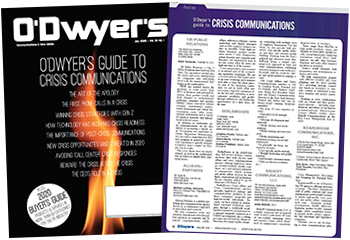 Gil Bashe, Kristie Kuhl and Jessica Berk-Ross co-authored this article Gil Bashe, Kristie Kuhl and Jessica Berk-Ross co-authored this article |
Some of the institutions that faced a crisis in 2019 didn’t fare so well. One key reason: transparency has entered the Age of Convergence. Social media, the 24-hour news cycle and instantaneous mobile technology connect individuals and lay out narratives side-by-side for all to examine. Suddenly, people who were isolated or compartmentalized can share common experiences and challenge cultural icons, celebrities and CEOs. An individual voice can be magnified exponentially with the addition of a hashtag.
In many cases where scandal rocked a company and would not go away, there are strong similarities. Some companies have not been seen to take real ownership of their mistakes or hesitate in formulating a response, which is seen as walking away from responsibility. Others responded to crises quickly, but with qualifiers and legalese that made the audience feel as though there was no one at the helm, no one responsible, only a team of corporate counselors.
 |
| This article is featured in O'Dwyer's Jan. '20 Crisis Communications Magazine. |
This is seen as a “non-apology” apology. These approaches may seem at first to distance the company that made the mistake from the act itself, but they do just the opposite, tying the perceived offender more closely to their offense. What both responses do is create distance and distrust between the company and its audience.
Charles Darwin wrote that “nature abhors a vacuum,” and human nature is no exception. In this Age of Convergence, if a company leaves any distance, that opening will be filled, digitally and at the speed of a keypad click. Audiences once geographically and demographically distant from one another find themselves on common ground in an online community, disparate digital voices can contribute to a new truth narrative.
For the Hallmark Channel, a convergence of individual perspectives meant one person’s opinion on or experience with discrimination could be affirmed by many others. A few tweets, a blog comment or two, followed by the drumbeat of others adding their voices, turned into such a groundswell of outrage that the network immediately caved to a moral watchdog group and dropped an ad depicting a same-sex kiss in a wedding ceremony.
It’s too soon to tell if Hallmark’s mishandling of their crisis will have long term impact on their bottom line, but in Boeing’s case, the self-inflicted 737 Max crisis, in which the aircraft manufacturer was never fully transparent, has caused a halt to Boeing production and shaken their previously rock-solid image, allowing the EU’s Airbus to overtake them in the market. The scandal will have lasting repercussions and impacts on the U.S. GDP and economy going forward.
For pharma leaders, it’s time to acknowledge that we live in the same digital ecosystem, where there are few secrets and little that can be hidden. Transparency is the coin of communications today, and when our image of events conflict with patients’, physicians’, payers’ and policymakers’ versions, we can expect that these audiences will converge, and their voices will emerge online.
Avoiding a reputation crisis is not easy, but companies weather the storm much better when they decide to embrace their responsibility and share transparently. While legal counsellors must be involved during a crisis, it’s critical that a place at the strategy table should be reserved for public relations practitioners—especially when litigation is at hand. Their role in aligning opinions, marshaling efforts with advocacy, lobbying and media/reputation management is what enables clients to guard their hard-earned reputation.
These six pillars of communications offer a framework for understanding and managing the flow of the dynamic.
Authenticate
The first step is to differentiate assumptions and feelings from fact: For example, in liability situations, why were there no cases at dozens of other area hospitals that had also received the same product? How was the product received, stored, handled and administered? Did the hospital in question have a record of safety problems? With patient safety paramount, these questions set the tone for ensuring that people stop pointing fingers and—most importantly—begin to think about how to guard against immediate risks.
Accuracy
Always get the facts right first, and then move fast to disseminate. One company worked diligently to guard its reputation by using the media to show its transparency in determining the facts, and by then working carefully to share its findings openly.
Align
Once answers to those questions are determined, communicators must agree. Ensure that everyone in the company’s legal, management, marketing, and sales teams convey the same truths whenever and wherever they interface with customers.
Ally
After core messaging has been established, ally with experts who can share and amplify those truths through their platforms. Cultivate and leverage third-party support, ideally before there is an issue. Always remember that whether they agree with your position or have their own point of view, advocacy groups will be called upon to comment. If they have no background, they are apt to play it safe even at your expense.
Assess
During a trial or crisis, it’s vital to monitor in real time for related news. In all crises and legal cases, assessing the mainstream and social media horizon 24/7, preparing and updating standby statements and making executives available for media inquiries is imperative.
Achieve
Think about the endgame, not the struggle! A rule of thumb: Do not panic every time you see unfavorable coverage or blog posts. But do not stand idly by either. Make sure key bloggers and reporters have the right information and connect with them to share facts, especially when they are in complex legalese. Aligning opinions requires that people have accurate information, so act when information is incorrect.
Public relations and public affairs professionals should have a key role in corporate crises situations and keep company officers on track with the company’s values and mission as a guide (e.g., putting people first). PR experts must ensure that not just shareholders, but also customers, influencers, policymakers, employees and supply-chain partners trust a client’s actions. They may not all agree; however, there should be no doubt that what you are saying is true and therefore, you are providing the other side of a complete story.
***
Gil Bashe is Managing Partner of Global Health at Finn Partners. Kristie Kuhl, JD, is Managing Partner of Biopharma at Finn Partners. Jessica Berk-Ross is Managing Partner of Public Affairs at Finn Partners.


 There’s a fine line between newsjacking and taking advantage, aka ambulance chasing. Our job as PR professionals is to tread it carefully.
There’s a fine line between newsjacking and taking advantage, aka ambulance chasing. Our job as PR professionals is to tread it carefully. PR firms need to be mindful of ways their work product may be protected by the attorney-client privilege whenever working with a client’s internal legal team or its external legal counsel.
PR firms need to be mindful of ways their work product may be protected by the attorney-client privilege whenever working with a client’s internal legal team or its external legal counsel. Manuel Rocha, former US ambassador and intenational business advisor to LLYC, plans to plead guilty to charges that he was a secret agent for Cuba.
Manuel Rocha, former US ambassador and intenational business advisor to LLYC, plans to plead guilty to charges that he was a secret agent for Cuba. CEO mentoring is an often-overlooked aspect of why CEOs are able to make good decisions, and sometimes make bad ones—all of which intersects with the role and duties of a board.
CEO mentoring is an often-overlooked aspect of why CEOs are able to make good decisions, and sometimes make bad ones—all of which intersects with the role and duties of a board.  How organizations can anticipate, prepare and respond to crises in an increasingly complex world where a convergent landscape of global challenges, threats and risks seem to arrive at an unrelenting pace.
How organizations can anticipate, prepare and respond to crises in an increasingly complex world where a convergent landscape of global challenges, threats and risks seem to arrive at an unrelenting pace.


 Have a comment? Send it to
Have a comment? Send it to 
No comments have been submitted for this story yet.